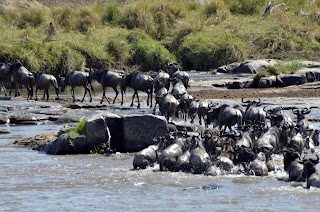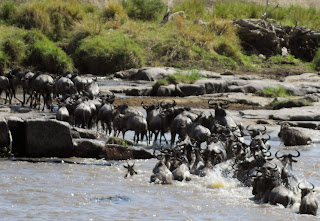Before we left for Tanzania, our travel agent Tracy had set us up with a guide from Wild Frontiers for the three days of our Northern Serengeti stay. This was a fabulous idea and the best tip I have for a self-drive safari during migration season!
We really had not felt like we needed a guide anywhere else in Tanzania before we got to the Northern Serengeti, but the Great Wildebeest Migration crossings are a whole different ballgame.
Knowledge and experience are key to seeing a crossing. Having a knowledgeable and experienced guide was invaluable to our being able to witness multiple crossings during our time there. Our guide's name was Onesmo Sanka and he has been leading safaris in the Serengeti for 14 years.
 Onesmo told us there are 10 crossing points on the Mara River. We saw crossings at numbers 4, 7 and 8. We started our day at the point which Onesmo felt held the most promise of a crossing that morning. Usually there would be a huge crowd of wildebeest already assembled and grazing near the river. Frequently there would be more coming in on a long line out of the savannah. We would choose a good vantage point, watch and wait.
Onesmo told us there are 10 crossing points on the Mara River. We saw crossings at numbers 4, 7 and 8. We started our day at the point which Onesmo felt held the most promise of a crossing that morning. Usually there would be a huge crowd of wildebeest already assembled and grazing near the river. Frequently there would be more coming in on a long line out of the savannah. We would choose a good vantage point, watch and wait.
And so would everyone else! It was the most people we had seen in Tanzania since we got there. Not too bad by South African standards, at the most crowded, we only counted about 20 vehicles.
Some of the vehicles got comfortable.
Real comfortable!
We didn't. Onesmo wanted to be ready to move on a dime.
This was a risky move because the crossing points were not all that close together. You risked the crossing being over by the time you got there.
And there was no telling what the impetus was for a crossing to start and therefore no way to really tell exactly when one would begin. All of a sudden, a lead wildebeest would break out into a trot and start the crossing. And everyone would follow in a single line.
There was really no way of knowing if the group you had been watching for twenty minutes and just left behind had been moments away from embarking on their own crossing. Stressful!
But Onesmo seemed to know. He had almost a sixth sense for whether the group would cross or not.
And what an amazing sight! It was like watching a tornado.
 |
| Crossing he Mara River |
And then finally for no obvious reason, the wildebeest would just stop crossing. There would still be wildebeest on the side of the river waiting to cross, but they wouldn't.
 |
| Yay! we made it. |
We took tons of photographs and reams of video. We are going to try to make a short film clip with the best parts of the videos we recorded.
In the meantime here are a few snippets of wildebeests ...
Milling about:
Being chased by safari vehicles:
Walking towards the crossing:
Running to cross:
Crossing the Mara River:
Crossing the Bologonja::
Close-up of the crossing:
We met plenty of people who came to see the migration who never even saw one crossing and we saw six. We were so blessed! We owe our good fortune all to Onesmo from Wild Frontiers in Tanzania and Tracy Woodland of African Sojourns in South Africa. Thank you!























No comments:
Post a Comment